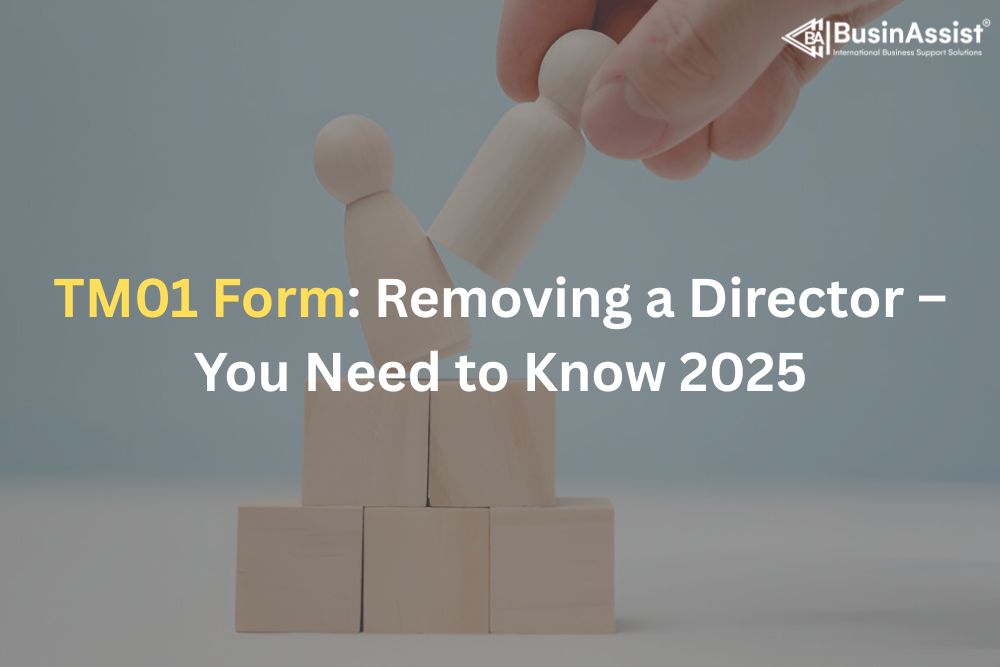Last Updated on November 5, 2025 by Joy Kyalo

There comes a time when a company has to terminate a director for neglecting their duties or misconduct. When that time comes, the termination must be per the legal requirements of the Companies Act 2006. A registered company has to comply with legal regulations and notify Companies House of the director’s termination. Company directors must be familiar with the TM01 form, which notifies Companies House of a director’s resignation or termination.
According to the Companies Act 2006, TM01 is the legal way to terminate a director. Here is a step-by-step guide on how to accurately complete the form.
Key Takeaways
-
- Form TM01 is the official way to notify Companies House of a director’s resignation or termination, and it must be filed within 14 days.
- Directors can be removed through resignation, Articles of Association, Companies Act 2006, service agreements, or even court/government intervention.
- Accuracy is crucial: ensure company details, termination date, and signatures are correct to avoid penalties, delays, or resubmission.
What is a TM01 form?

A TM01 form is a legal document that notifies Companies House that a director has resigned or been terminated. This ensures the company is transparent with Companies House and keeps accurate and up-to-date records.
The form will include the details of the outgoing director, such as their name, residential address, the date of appointment, and the effective date of resignation or termination. The form should be sent to Companies House within 14 days of the termination. The formal notification will allow Companies House to update your company’s records on the public register.
Now that we have understood what Form TM01 is, we will look into how a company can terminate a director in the next section.
Download TM01 form Now: Click here
How to terminate a director?
A company may decide to terminate a director for various reasons; however, the company should comply with the Companies Act 2006, articles of association, service agreement between the director and the company, and shareholders’ agreement.
A director may be terminated by:
Voluntary resignation:
You may ask a director to resign voluntarily to avoid dismissal proceedings. This helps the director avoid potential legal proceedings, which may damage their reputation. It also helps save the company and the director’s time from the lengthy, complex process and negotiate a better exit package.
Dismissal under the Articles of Association:
The articles of association contain multiple provisions on why a director should be immediately terminated. With such laid-out powers, it will be easier for the board of directors to dismiss a director if they go against the provisions in the articles of association.
Removal under the Companies Act:
A director can be removed by ordinary resolution at a meeting before their expiration period according to section 168 of the Companies Act 2006. The resolution has to be passed in a meeting and not in writing. A special notice will also be required to be given to the company at least 28 days before the meeting.
Removal under the service agreement:
This employment contract lays down roles, agreements, and clauses that may lead to the director’s termination. The service agreement may suggest that a director voluntarily resign instead of being dismissed.
Removal by the court or other government agencies:
The Companies Act 2006 has given the court the power to terminate a director if their conduct is deemed ‘unfit’.
Other government agencies that can terminate a director include Companies House, HMRC, the Financial Conduct Authority, and the Competition and Markets Authority (CMA).
How to complete form TM01

Enter company details:
The first step in the TM01 form is to fill out company details such as the company name and company number. The information should be accurate to ensure the termination is attributed to the right company.
The outgoing director’s current details:
Insert the outgoing director’s current appointment details held on the public register. The details include date of birth, titles, and full names. This information ensures Companies House identifies the correct person on the public record.
Effective date of termination:
Highlight the effective date of the termination. This is important as it marks the date the director is no longer responsible for the company’s responsibilities. It is important to note that only one director appointment can be terminated per form.
Signature:
Since the terminated directors cannot sign the TM01 form by themselves, an active authority within the company will sign the form on behalf of the company. The form can be signed by a director, secretary, authorised person, liquidator, administrator, administrative receiver, receiver, receiver manager, charity commission receiver and manager, CIC manager, and judicial factor. The person authorised should be under either section 270 or 274 of the Companies Act 2006.
Pro Tip: Submit Accurately and On Time
Always double-check company details, director information, and the effective termination date before sending the TM01 form. Submitting accurate data on time avoids rejection, penalties, or delays and using the online option gives you instant confirmation.
Presenter information:
Fill out the information of the person presenting the form to Companies House. This information will help Companies House if there is a query on the form. The information includes contact name, company name, address, country, postcode, county/region, telephone, DX, and postcode.
Submitting to Companies House:
You can submit the form to Companies House online or by post. Keep in mind that the form should be submitted to Companies House within 14 days of termination. Failure to notify the Registrar on time may lead to penalties or even legal consequences.
For the online submission, ensure to pay attention to the specific guidelines and instructions provided on the Companies House website. This process is quick and immediate.
For paper submission, the form should be sent using the registered office address mail to ensure it is delivered safely, and it helps to retain proof of submission.
What are the common mistakes you should avoid while completing Form TM01?
Incorrect or incomplete company details: Ensure you fill out accurate company details. The omission of one thing or even a letter may lead to confusion or delay in processing the form. If it’s the company’s name, ensure to enter the whole name, including the ‘Ltd’ or ‘LLP’ if applicable.
Omitting the effective date of termination: The effective date of termination means the date when the director in question will stop working in the company. The date must be accurate since Companies House will update the information on the public records. Omitting or filling out the wrong date may lead to legal consequences.
Not signing the form: Not signing the form means it is incomplete, which means you will have to resubmit another form. This may result in delays, which may lead to penalties. Companies House must be notified about a director’s termination within 14 days.
In summary, form TM01 is a legal way to terminate a director according to the Companies Act 2006. Companies must maintain accurate and up-to-date records. After notifying Companies House, the records will be updated on the Companies House public register.
It is important to ensure the details you fill in the form are accurate. Omission of one word or letter may bring confusion or term the form invalid, requiring resubmission of another form.
FAQs
Q: Can a resigning director sign the form TM01?
Ans: Yes, a resigning director has to sign the form TM01 and send it to Companies House within 14 days of resignation.
Q: What is a TM01 form?
Ans: This is a form that is used to notify Companies House that a director is resigning or has been terminated. The TM01 form is a legal form to remove the director of a registered company from office. This is a way for companies to stay transparent with Companies House and keep their company’s records up-to-date and accurate.
Q: Can I sign my TM01 form?
Ans: According to Companies House, the only person who can sign the TM01 form is a serving director. So, if you are resigning, you can sign the TM01 form as long as the date the form was signed is no later than the date of resignation. However, a terminated director cannot sign the TM01 form. The only person allowed to sign the form is an active authority within the company.
Q: Can I submit a TM01 for myself?
Ans: Submitting the TM01 form depends on how you are leaving the company. You can submit a TM01 form for yourself on behalf of the company if you are resigning. However, if you have been terminated, you cannot submit the TM01 form by yourself.
Q: How to get a TM01 from Companies House?
Ans: The TM01 form can be downloaded from the Companies House website. Go to https://www.gov.uk/government/publications/terminate-an-appointment-of-a-director-tm01 and download the form in PDF format.
Read Also:
- Company Pension Contributions for Directors: A Comprehensive Guide to Planning for Retirement
- Everything You Need to Know About How Long a Director Is Liable After Resignation
- What Happens to Directors When a Company is Dissolved?
- Key Legal Differences Between Executive and Non-Executive Directors
- A Step-by-Step Guide to Resign as a Director of a Limited Company
- Can a Company Be a Director of Another Company: Legal Insights for 2025
- How to Check if a Company Is Legit: Every UK Entrepreneur Should Know

Joy is a content writer at BusinAssist with 6+ years of experience in content marketing and social media strategy. She specialises in company formation and virtual operations, guiding entrepreneurs through global markets with clarity, drawing on her marketing and PR background. Business Assist with BusinAssist – your business success partner.


What if a co-director in a Private Limited Company, in bad faith, signs and submits a TM01 form without the knowledge and consent of the other named director. What can the ‘resigned’ director do to be able to rectify such a situation?
Thank you for your question — it’s a very important one.
If a TM01 form is submitted in bad faith without a director’s knowledge, the ‘resigned’ director should contact Companies House immediately to report the issue. They should provide evidence that the resignation was not authorised and request to have the record corrected. It’s also advisable to seek legal advice, especially if the removal was done without following the correct company procedures.